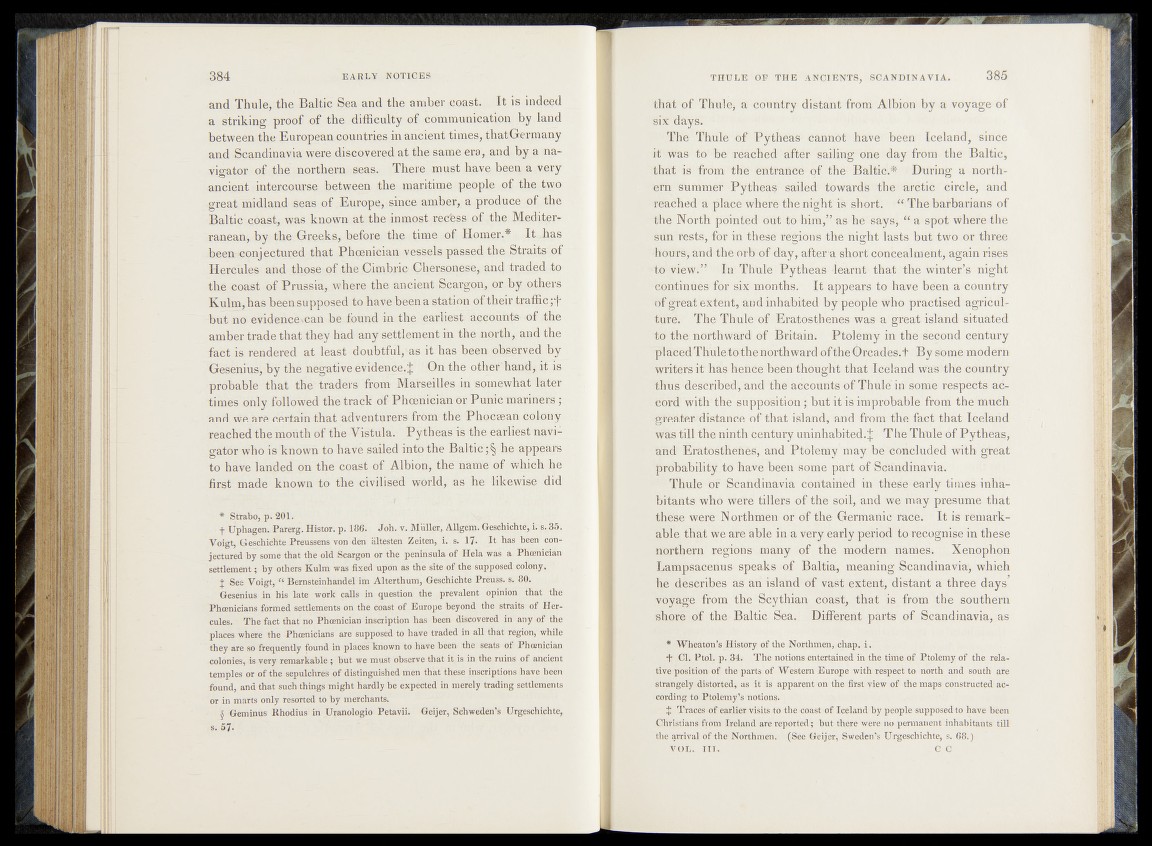
and Thule, the Baltic Sea and the amber coast. It is indeed
a striking proof of the difficulty of communication by lapd
between the European countries in ancient times, thatGermany
and Scandinavia were discovered at the same era, and by a ‘navigator
of the northern seas. There must have been a very
ancient intercourse between. ,tlie, juaritime people of the two;
-great midland, ;Seas of .Europe, since amber, a produqejof „tjie
Baltic; <j.oast, was known at the inmost-recbss pf the Mediterranean,
by the Greek s,-b.efore the.;time of Horner.* I t jia s
beemnonjeotured that Phoenician vessels .passed the Straits ,of
Heppiles ahd those-pf the Cimbrio Cl\erspnese^fnd:tradedrft©
the coast of Prussia, where th e ancienti.icargon,. or by$|hprs
Kulm,has been supposed to hayefoeen a station of their traffifcgijff
■but no evid'ehcefoan be found in the earliefeh^¥?eQiuntS‘-®f-sthc
amber, trade that they had any settlement in fehemprtl^ a n d ^ e
fact is rendered at least doubtfuTj*as it hasj|p^^bgeEyed b y :
Gesenius, by the negative evidence.% On4H§|fther:'hand,- ip s
probable that the" traders from M ar settl ^ n ’^oni'ewh'at-fetet
tirn^7only followed the track of Ph&TSieiafl-pr P u n ic i^ rii^ p f;
and we are certain that adventurers from the Phpciean colony*
reached the month of the Vistula/ P y t b e a ^ i '^
jgatfdr who is known to have sailed info the Balti^fe^e
to have landed on the coast of Albion, the n aW .|||‘whjch h|>
first made known to the civilised world, as' be likewise^ did
* Strabo, p. 201.
f Uphagen. Parerg. Histories 186. Job. ▼. Muller, Allgem. Geschichte^ irs. 35.
Voigt, Geschichte Preussens von den altesten Zeiten, i. s. 17.^m*- has been conjectured
by some that the old Scargon or the peninsula of Hela Vas a Phoenician
settlement; by others Kulm was fixed Upon as tbe site of the supposed colicmy.
■ % See Voigt, « Berosteinhandel im Altetthum, Geschichte Preuss. fe80.
- Gesenius in-bjs late work calls in question the prevalent opinion that the
Phoenicians formed settlements on the cpast of Europe beyond the straits of Hercules.
The fact that no Phoenician inscription has been discovered itf-’any of the
places where the Phoenicians are supposed to have traded in ail that region,1 while
they are so frequently found in places known to have been1 the seats of' Phoenician
colonies, is-very remarkable; but we must observe that ltj is ih -the ruins of ancient
temples or of the sepulchres of distinguished men that'these inscriptions have been
found, and that such things might hardly be expected in merely trading settlements
or in marts only resorted to by merchants.
• j Geminus Rhodius in JUranologio Petavii. Geijer, Sch-Weden’s Urgesehichte,
'».57.
that of Thule, a country distant from Albion by a voyage of
six ddysl" *
The Thule bf Pytheas cannot have been Iceland, since
it was to 'b e reached after sailing one day’from the Baltic,
that iS‘ from the entrance ^f the Baltic.* During a northern
stammer Pytheas sailed towards the arctic circle, and
ffipached ja place whered>hfe night* is^^h-ort.1 “ The barbarians of
the North pointedvoât!to him/7 as1 he'-says; “ a 4spot where the
subftests, for in these region's the nigbtdasts but two or three
fooWrs) and the hï-b' of day, after >a short5 cPncealment, again rises
Jo view.” In; Thule Pythea's-’dearnt that the winter’s night
•continués* for six months. It appears to have been a country
of great extent, and inhabited by people who practised agriculture.
’ The-Thule of Eratosthenes was a* great island situated
to the northward of Britain. Ptolemy in the second century
’plâihédThuleto the northward of the ©rcades# By some modern
writers it* has hehfé been thought* that -Iceland w*a's thé country
thus described/and the accountS-of ThùM in some) respects accord
with-the supposition ; butit%jm'probable from the much
greater-distance of that island, and from the fact that Iceland
was till the ninth century uninhabited.^ T he ThuleÔf Pytheas,
and EratostheftesV and Ptolemy may be concluded with great
probability to have been éupâfe part of Sc’aridinavia.
Thule o?‘Scandinavia contaihèd in th ^ ^ é a rly times inhabitants
who were titters of-thé soitlland we may presume that
tb&e were% Northmen or of the Germanic'race. It isfremarkable
that we aré able in-a very è‘arly period to recognise in these
northern régions' many of the modern nameSt ' Xenophon
Lampsacenus speaks -of Baltia, meaning Scandinavia, which
he dèséribes as an island of vast extent, distant a three days
voyage from the Scythian ppast, that is from the southern
shore of the Baltic Sea. Different parts of Scandinavia, as
• Wheaton’sHistory of theNorthmen, chap, i.
+ Cl. Ptol. p.,34. The notions entertained in the time of Ptolemy of the relative
position of the parts of Western Europe with respect to north and south are
strangely distorted, as it is apparent on the first view of the maps constructed according
to Ptolemy’s notion».
$ Traces ofearlier$$5its to the coast of Iceland by people supposed to have been
Christians from Ir'eland are reported ’; but there were no permanent inhabitants till
the arrival of the^Northmen. (See Geijer, Sweden’s Urgesehichte, s. 68.)
VOL. III. " ' C O